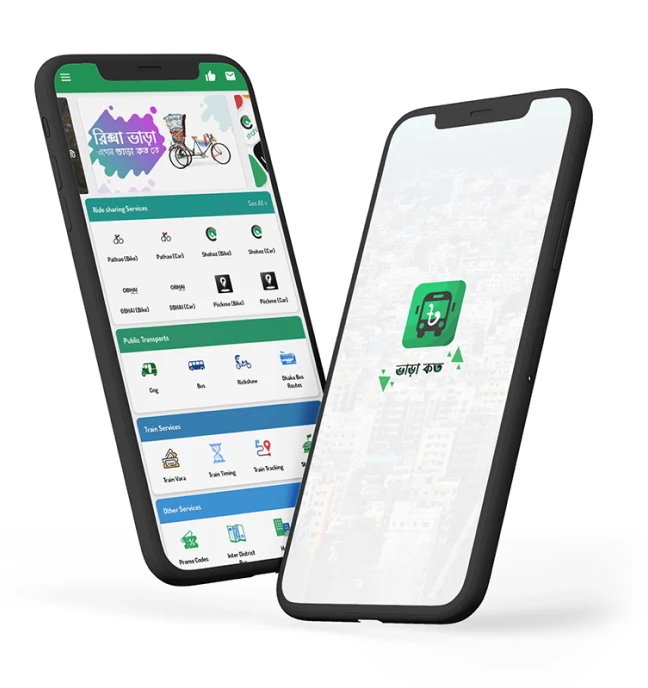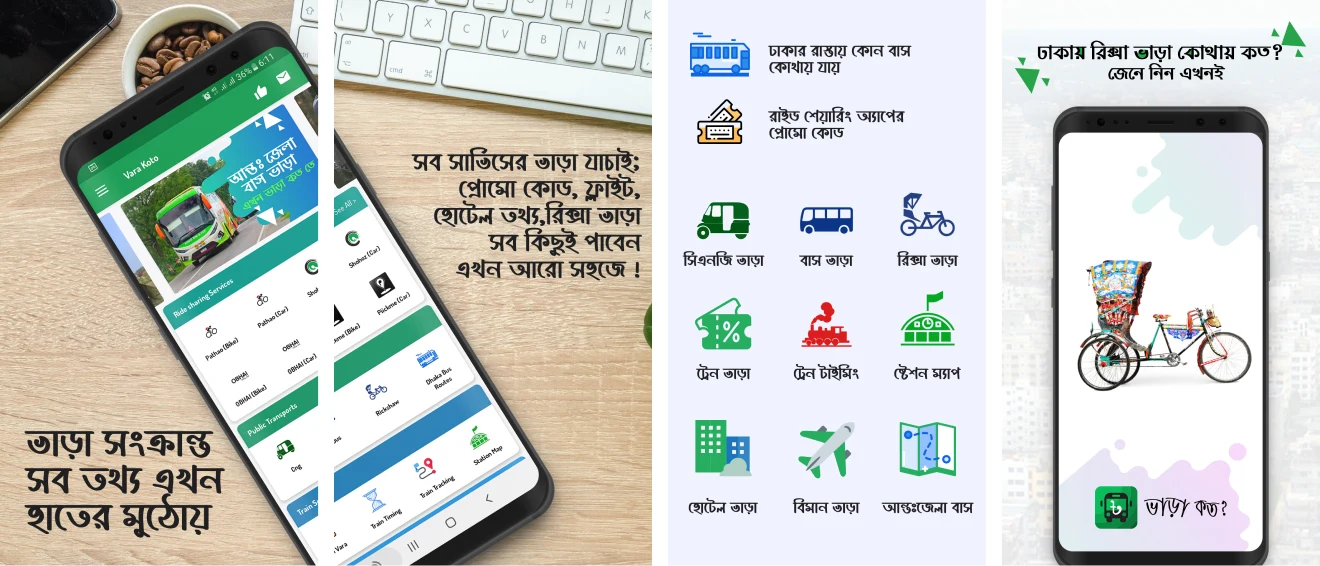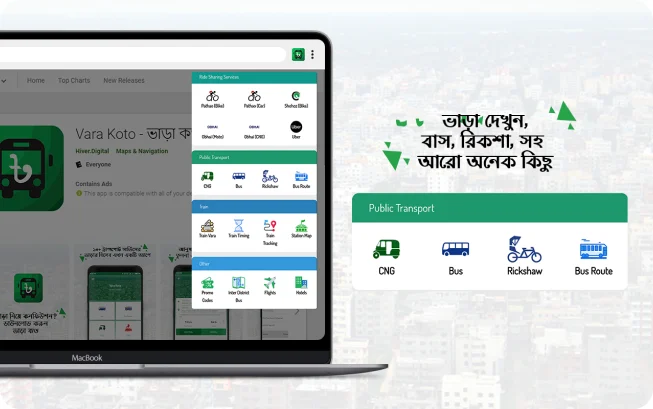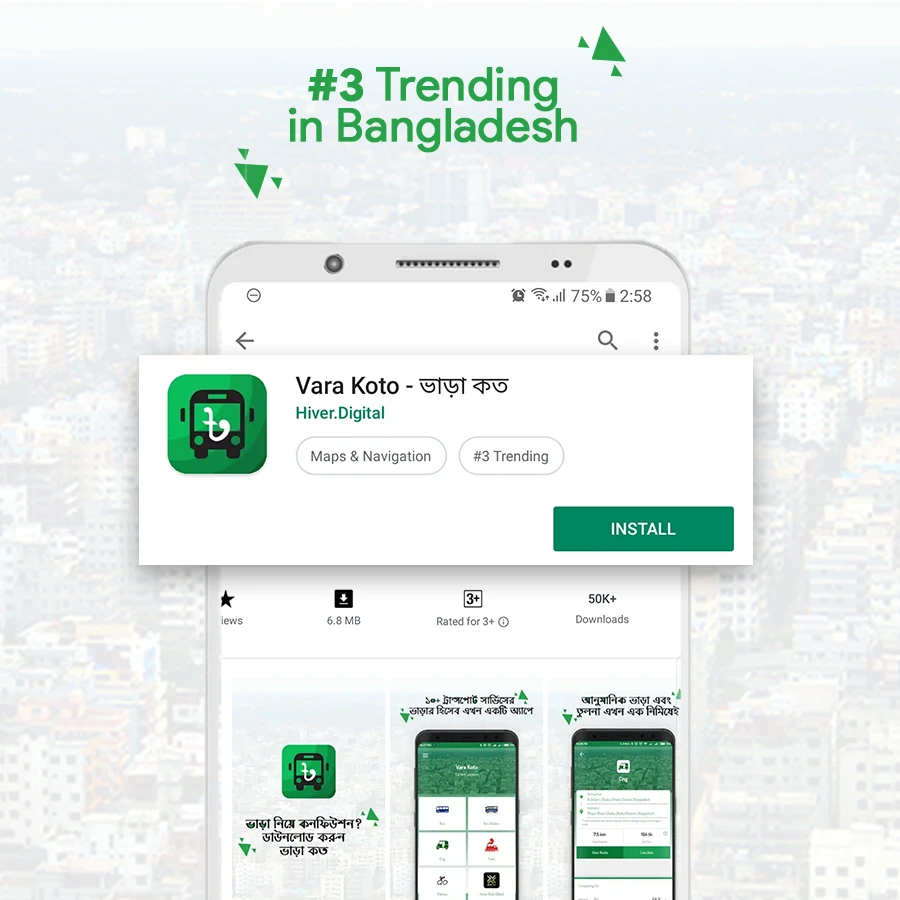Designing end-to-end user experience and solution for Vara Koto apps.
Client :Hiver.DigitalThe Project Overview
Hiver.Digital was planning for a solution which is a fare calculation app that let a user compare transport fare between 15+ providers in Bangladesh. This app will ease the users' pain to switch between Uber, Lyft, Pathao, Shohoz and other ride-sharing apps to know the cheapest option for their ride. I’m one of the co-founders of this solution. The goal of this design project was to design a personalized and easy to use mobile and web application.
My responsibilities
- Lead and conduct user research
- Prototype, wireframing and user testing
- Dev Hand-offs
- Landing pages design and development
Tools
- Figma
- Adobe Illustrator, Photoshop
- Invision
- Bootstrap
- ReactJS
Links
- Google Play Store : https://bit.ly/vara_koto
- Web App : https://varakoto.web.app/
- Landing Page : https://varakoto.hiver.digital/
- Chrome Ext:
http://bit.ly/vara_koto_chrome
🏆 Achievements
In the 1st Year
Review
In Bangladesh
International Award
Background
Vara koto is a fare calculation app that let a user compare transport fare between 15+ providers in Bangladesh. It also lets users know promo codes, bus route information, train fare and schedule, rickshaw fare, inter-district bus fare and more. Learn more about what Vara Koto does.
I co-founded Vara Koto in 2016 and acting as a product designer since then. We have 1 developer and 2 business experts. I'm supporting design across every aspect of our business and am responsible for leading UX and UI across key parts of the application side of the platform.
Here are some key achievements that I've gained in the last couple of years.
- Implemented a design process: This has helped our team streamline our workflow and ship features more efficiently.
- Improved user engagements across the platform: I’m constantly working towards conducting UX research and usability testing. As a result, in 2021, we saw 56.5% growth in our userbase.
- Establishing a design system: I created and currently maintaining a comprehensive design system for our products. This helped the team to understand how and why we choose to implement certain features over others.
🚦 The Process
I follow these 6 stages to design process to sort out the design goals and implementation. You can learn more about each of the processes here. By the way, this article was also written by me during one of my copywriting projects with UXPin.

⚒ ️The Problem
Right now, 15+ ride-sharing providers are operating in Bangladesh. Uber, Pathao, Shohoz are some of the popular ones. They offer different fares for different services. If a user wants to go from point A to point B, he needs to check all the apps one by one to get the cheapest option. Public transportation is another story. Riding on local transport here in Dhaka is like winning a battle for the city dwellers! But it is not the end of the story; it is just the beginning! Because the war starts later on whenever they are to pay their transport fare!
Several public transportation services are available in the city, e.g. Local Bus,Taxi, CNG, Tempo, etc. A Government fixed fare policy is also available for all the transportation modes. But unfortunately, you will not get anyone charging according to that. They charge whatever they want!
During our initial market research, we listed the following problems of our users.
- Users don't have an efficient way to check their cheapest transportation options.
- Users can't get an estimated fare for the destination while using local transport.
- Users don't have an efficient way to know all the promos and discounts offered by the different ridesharing services.
- Users don't have an option to know about different local bus services fare and their routes.
- It's hard to get Inter-district bus fare and service information.
🔎 Conducting Researche
I started my research by interviewing potential users about their problems. I tried to pinpoint their challenges and the difficulties while using public transport. The key findings of my 15 days of research are below:
- The majority of potentials users are between ages 20-40.
- About 73% of potential users use public transports at least twice a day. 5 days a week.
- 79% of potential users have a smartphone with an active 3G/4G internet connection while using public transport.
- 90% of potential users live in urban areas.
User Personas
With the data gathered from market research, I started to generate provisional personas using statistical knowledge. These represent a certain type of user that is the potential audience of our solution. These personas will help me screen appropriate people to interview.
Frequent Public
Transport User
Age 20-30 | Android Smartphone User | Use public transport for work commute
Pain Points:
- Facing difficulties while finding information about local bus routes.
- Bus fare change frequently, hence can’t find reliable fare information.
Frequent Ride
Sharing Service User
Age 20-30 | Android Smartphone User | Use public transport for work commute
Pain Points:
- Need to jump between 4-5 app just to get the cheapest and reliable option.
- Don’t have an efficient way to be informed about promos and discounts offered by different service providers.
Frequent
Rickshaw User
Age 19-50 | Android Smartphone User
Pain Points:
- Facing difficulties while finding proper information about rickshaw fare for different destinations.
🎭 Sketching and prototyping the proposed solution
With research data in hand, We decided to build an Android app and web application. That will let the user input starting location and destination location, and then it will automatically calculate the fare of different service providers. Users will be able to compare the fare from one screen. Also, the user will be able to launch different service provider app directly from our solution.


🎨 Building Designs
I created a comprehensive design system for a solution. That includes different typography, icons, cards, modals, and other UI elements. One of my base design frameworks was Google's material design. The initial design system took two weeks to create.



🚀 Implementation
After five weeks of design, iteration and experimenting, we finally start implementing our design to product development. I worked closely with engineers to develop the designs for MVP. I scoped out tickets for the front-end engineers with user stories and product requirements. I also encouraged the team to look into the clickable prototype to quicken the implementation process and worry less about the component interactions.

Splash screen and
Home screen

Promo codes , Fare Calculation,
Inter-district bus fare

Web Application
https://varakoto.web.app

Google Play Store Screenshots




Vara Koto Chrome Extension
⚡Results and takeaways
Working in an early-stage startup was a challenging experience. It taught me a lot about being lean and knowing when and where to focus your energy and efforts.
Some key takeaways from this project are:
- Focus on building an MVP: There is only so much time and effort that you can invest in a startup. So it's important to focus on the features that can deliver the highest value for your users.
- Focus on the UX first: Earlier in my journey, I made the mistake of worrying about the look of the UI. Taking a step back and reassessing the user flows helped me to reprioritise the UX.
- Focus on the problem: At the end of the day, you'll be solving your users' pains. It's easy to lose sight of this when you're bogged down in the day-to-day. So we need to keep that in mind.

